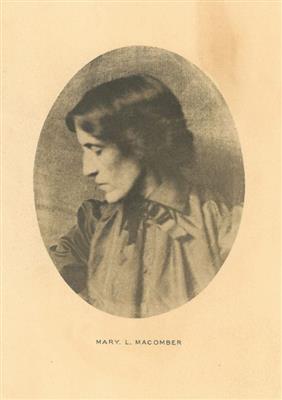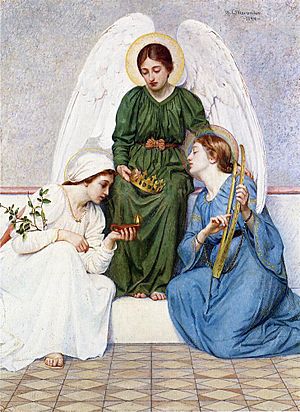Mary Lizzie Macomber facts for kids
Quick facts for kids
Mary Lizzie Macomber
|
|
|---|---|
 |
|
| Born | August 21, 1861 Fall River, Massachusetts
|
| Died | February 4, 1916 (aged 54) Boston, Massachusetts
|
| Nationality | American |
| Education | Boston Museum of Fine Arts |
| Known for | Painting |
| Movement | Pre-Raphaelite |
Mary Lizzie Macomber (born August 21, 1861, died February 4, 1916) was an American artist. She was known for her beautiful paintings in the Pre-Raphaelite style. This art style focused on detailed beauty, nature, and stories from history or myths.
Contents
Mary Macomber's Life and Art Journey
Mary Lizzie Macomber was born in Fall River, Massachusetts. Her father, Frederick William Macomber, was a jeweler. Her family had a long history in America, with roots in the Quaker and Pilgrim communities.
Early Art Training
As a young girl, Mary took painting lessons. Her first teacher was Robert S. Dunning. He was a famous painter known for his still life art. After about three years, Mary went on to study at the school of the Boston Museum of Fine Arts.
In 1883, she had to stop her studies because she became ill. After she got better, she continued her art training. This time, she studied with another artist named Frank Duveneck.
Opening Her Own Studio
Around 1885, Mary Macomber opened her own art studio in Boston. At first, she painted still life pictures. These are paintings of objects like fruit or flowers. Later, she started to focus on "allegorical" works. Allegorical paintings tell a story or show an idea using symbols and figures.
Her first painting to be shown in public was called Ruth. It was displayed at the National Academy exhibition in 1889. Over the next 13 years, she showed more than 25 paintings there.
Famous Exhibitions and Awards
In 1893, two of her paintings were shown at a very important event. These were Love Awakening Memory and The Annunciation. They were part of the World's Columbian Exposition in Chicago. This was a huge world's fair.
Mary Macomber also won an award for her painting St. Catherine (1897). It won the Dodge prize at the National Academy exhibition in New York. Some of her other well-known artworks include Love's Lament (1893) and The Hour Glass (1900). She also painted The Lace Jabot (1900), Night and Her Daughter Sleep (1903), and Memory Comforting Sorrow (1905).
Besides painting, Mary Macomber also wrote poetry. She even published a book of her poems in 1914.
Later Life and Legacy
Sadly, a fire in her studio in 1903 destroyed many of her artworks. Mary Macomber passed away in Boston in 1916. She was 54 years old. Today, her paintings can be found in important places. These include the Smithsonian and the Museum of Fine Arts, Boston.
Amazing Artworks
See also
 In Spanish: Mary Lizzie Macomber para niños
In Spanish: Mary Lizzie Macomber para niños






